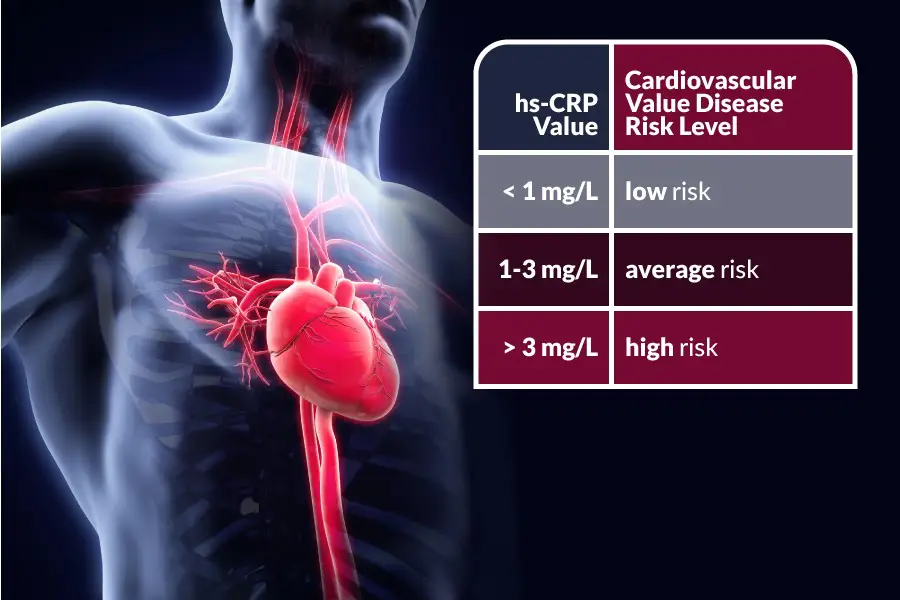The CRP level is considered a marker for inflammation. It is therefore also an important early warning sign for infections and cardiovascular diseases. An hsCRP test, which can detect even small amounts of CRP in the blood, is often performed.
What is CRP?
CRP stands for C-reactive protein. This blood protein is an inflammatory marker—a measurement that indicates inflammation in the body.
CRP is produced in the liver and from there enters the blood. The protein is a component of the immune system. It is involved in the body’s cleanup work. Above all, CRP helps the body detect remnants of dead immune cells, bacteria, and fungi. It calls the immune system’s phagocytes into action, which eliminate these remnants.
The concentration of CRP can be measured in the blood.
What does the CRP value indicate?
The CRP level is measured, among other things, when a chronic infection or other inflammatory disease is suspected. Doctors can also use CRP to assess the severity of an inflammation. For example, the level is used to determine whether acute pneumonia is present [1].
CRP level as a cardiovascular risk factor
In addition, the value is considered a risk factor for arteriosclerosis and cardiovascular disease. Studies have shown, for example, that people with harmful plaque deposits in their blood vessels have higher CRP levels on average [2].
This means: If the CRP level is elevated and there is no other clear cause, you should pay particular attention to preventative measures for your heart and blood vessels.
5 milligrams per liter (5 mg/l) is considered the limit for CRP in healthy people.
When is the CRP level elevated?
CRP levels above 10 mg/l are considered significantly elevated. This applies to all age groups and genders. In this case, it doesn’t necessarily indicate a disease, but it is a sign of inflammation in the body. A CRP level above 10 mg/l is often triggered by the following factors:
- acute infections with viruses
- serious injuries
- Inflammation of the blood vessels (vasculitis) that occurs in rheumatic diseases
- other chronic inflammatory diseases, such as Crohn’s disease, autoimmune diseases, and diabetes mellitus
Levels of 50 mg/l and above are assumed to indicate an existing illness. In 90 percent of cases, CRP levels this high indicate a severe bacterial infection, such as hepatitis C or pneumonia. In some cases, viruses or parasites can also cause such high levels. CRP is used, for example, as an indicator of dengue fever (a virus) or malaria (a single-cell parasite). Severe burns or blood poisoning (sepsis) can also lead to extremely high CRP levels [3].
Tip: However, you should always have significantly elevated values interpreted by a doctor – it is important to find the cause of the inflammation in the body.
In which diseases is the CRP level elevated?
In the previous sections, we have already explained how elevated CRP levels are related to various diseases.
Here is a list of typical examples:
- Infections with viruses, bacteria, parasites, or fungi – from the common cold to severe bacterial infections such as pneumonia and dangerous infectious diseases such as malaria
- Consequences of infectious diseases, such as Long COVID
- Tissue damage caused by injuries, such as wounds or burns
- Arteriosclerosis and other damage to the blood vessels
- Chronic inflammatory bowel diseases such as Crohn’s disease
- Rheumatic diseases
- Autoimmune diseases
- Diabetes mellitus
What can you do about elevated CRP levels?
Anything that inhibits inflammation causes the CRP level to drop.
Common healthy lifestyle tips help counteract such inflammation in the body. These include regular exercise, getting enough sleep, managing stress, quitting smoking, and reducing alcohol consumption.
Inflammation and obesity: In severe obesity ( obesity ), inflammatory markers such as CRP are typically elevated. Sustained weight loss can then lower CRP levels accordingly. However, studies have also shown that elevated inflammatory markers are not an indication of weight gain. Therefore, obesity is likely the first cause, which in turn leads to increased inflammation [4] .
Diet against elevated CRP levels
Diet plays a particularly important role. An anti-inflammatory diet rich in fruits, vegetables, and fiber from whole grains and legumes is often recommended. These foods provide vitamins A, C, and E, as well as minerals such as zinc and magnesium. All of these nutrients help regulate inflammation in the body, and people who eat few fresh fruits and vegetables are often found to be overweight and have elevated CRP levels [5].
Spices such as ginger, cinnamon, and turmeric are also considered anti-inflammatory. Highly processed foods, sugar, and red meat should be consumed in moderation.
Anti-inflammatory substances – such as ginger, cinnamon, turmeric, and garlic – are often used in dietary supplements. Several studies have already shown that such preparations can reduce inflammation and lower CRP levels.
Compensate for nutrient deficiency.s
When it comes to other nutrients that counteract inflammation, it’s especially important to avoid deficiencies. This applies, among others, to vitamins and minerals that have antioxidant effects, such as zinc, selenium, vitamins C, and E.
In recent years, scientists have also focused on how vitamin D and omega-3 fatty acids are related to inflammatory markers such as CRP.
Vitamin D: Studies show that a vitamin D deficiency can lead to mild but chronic inflammation in the body. Replacing a deficiency with supplements can also reduce inflammation [8].
Omega-3: Unsaturated omega-3 fatty acids are considered anti-inflammatory. Their counterparts are omega-6 fatty acids. The problem is that our modern diet causes us to consume far more omega-6 than omega-3, which shifts the ratio of fatty acids. This imbalance promotes inflammation and can thus also increase CRP levels. In addition to omega-3 supplements, some foods also provide omega-3. These include fatty fish and vegetable fats with a favorable fatty acid composition, such as olive and rapeseed oil [9].
Detect and treat diseas.es
If an elevated CRP level is due to a disease, the only way to lower CRP is usually to treat the disease. That’s why it’s so important to find the exact cause of elevated inflammation.
Some illnesses can be cured or resolve over time—many infectious diseases, for example. Other chronic illnesses require appropriate treatment. This ranges from lifestyle and dietary changes to long-term medication.
For example, statins are often prescribed long-term to treat elevated cholesterol levels. Well-controlled cholesterol levels subsequently reduce inflammation and the risk of atherosclerosis.
What is hsCRP?
When determining inflammation levels, hsCRP, or highly sensitive C-reactive protein, is often also measured. The test’s high sensitivity means that even small amounts of CRP can be detected in the blood.
hsCRP is primarily used as an early warning sign of atherosclerosis and heart disease. Studies have shown that people with elevated hsCRP levels have, among other things, a higher risk of suffering a heart attack in the next few years.
The test is recommended, among other things, if people suspect that they have an increased risk of heart attack, for example, because there have been cases in the family or because there are risk factors such as high cholesterol or high blood pressure.
In addition, hsCRP, like the CRP value, can indicate inflammatory diseases.
This also presents the limitations of the test: The value does not provide any information about the cause of the inflammation. An elevated hsCRP level could be due to arteriosclerosis, but also an autoimmune disease, an infection, or other reasons. Therefore, if an abnormal result is obtained, it is important to conduct further tests to determine the exact cause [10].























+ There are no comments
Add yours